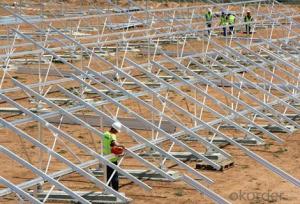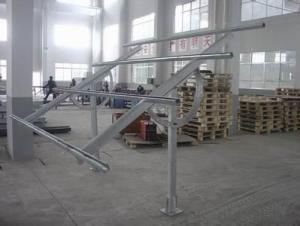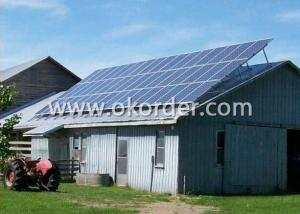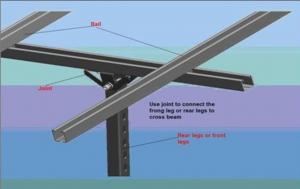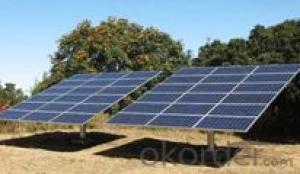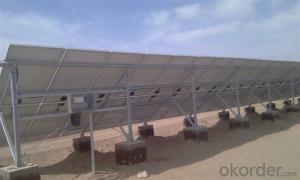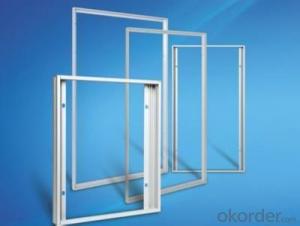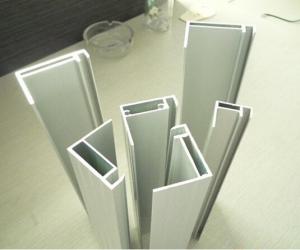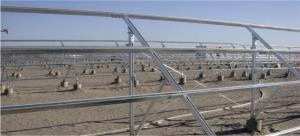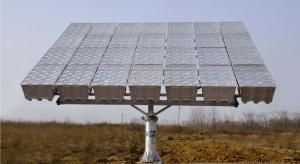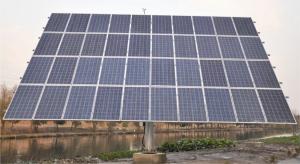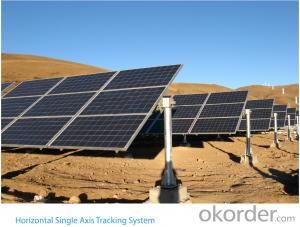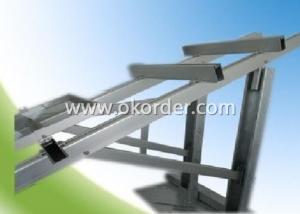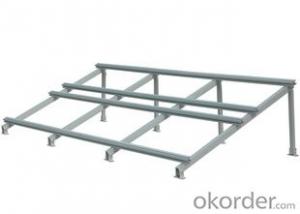Solar Panel Monting System TT-SK-01
- Loading Port:
- Shanghai
- Payment Terms:
- TT OR LC
- Min Order Qty:
- -
- Supply Capability:
- 50万套 set/month
OKorder Service Pledge
OKorder Financial Service
You Might Also Like
PV Mounting brackets are special solar photovoltaic systemfor placing, installing, fixing the solar panel design. Generally materials arealuminum, steel structure, stainless steel. PV mounting products at groundmounting system, flat roof mounting system, adjustable angle roof rack system,inclined roof rack system, column bracket system.
The Ground Mounting System including concret basement sysytemand steel pipe sysytem, Titanergy provides total solution for flat or pitchedroof with patent products.On the basis of the given project data, specificnational standards and guidelines, Titanergy will calculate the completestructural analysis and create a complete project plan to make sure reliablestructural safety.We provide high quality HDG steel and aluminum products forthe ground mounting sysytem,witch can make sure the security and durability ofthe project.
Features and Advantages
n The rail bracket is easy to install, just use simple tools(eg, Allen wrench) can be easily installed. Rail connecting member can freelyadjust the length, the stent may be pre-installed on the roof, and thenappropriately adjusted according to the size of the solar panel.
n The combination of strong, aluminum rails and card blocks fora variety of venues and a variety of materials roofs (such as metal, ceramicand other kinds of tile surface)
n Component compatibility, and rail can meet PV modules fromdifferent manufacturers.
n accuracy, the length of the rail to the nearest millimeter,the construction process, not because of the length is too long or too shortfor the second cut.
n flexible assembly, rail hooks can adjust the spacing modulearray and tile has been installed successfully address the uneven roofconstruction led to difficult problems.
n design standards, product design and development process instrict accordance with GB, the German standards and other internationalstandards to ensure products reach the world advanced level.
n Quality assurance, the stent main material is high-qualityaluminum and stainless steel, effectively prevent corrosion of oxidation.Products can be recycled, reducing environmental pollution.
n Carried out strictly according to the current specificnational standards
n Perfectly optimized components and complete structuralanalysis for the sysytem
n High corrosion resisitance ensure the stability and highdurability
n Total test and certification make sure the high quality ofthe products
n Maximum pre-assembled in factory,quick mounting onsite,timesaving
10-year durability warranty
Technical Data
n Design Period:25 years
n Installation Site: Open area
n Array Angle:10°~60°
n ModuleType:Framed or unframed
n Material:Q235B,Al 6063-T5,Al 6005-T5,StainlessSteel A2-70
n Coating:HDG/Anodised
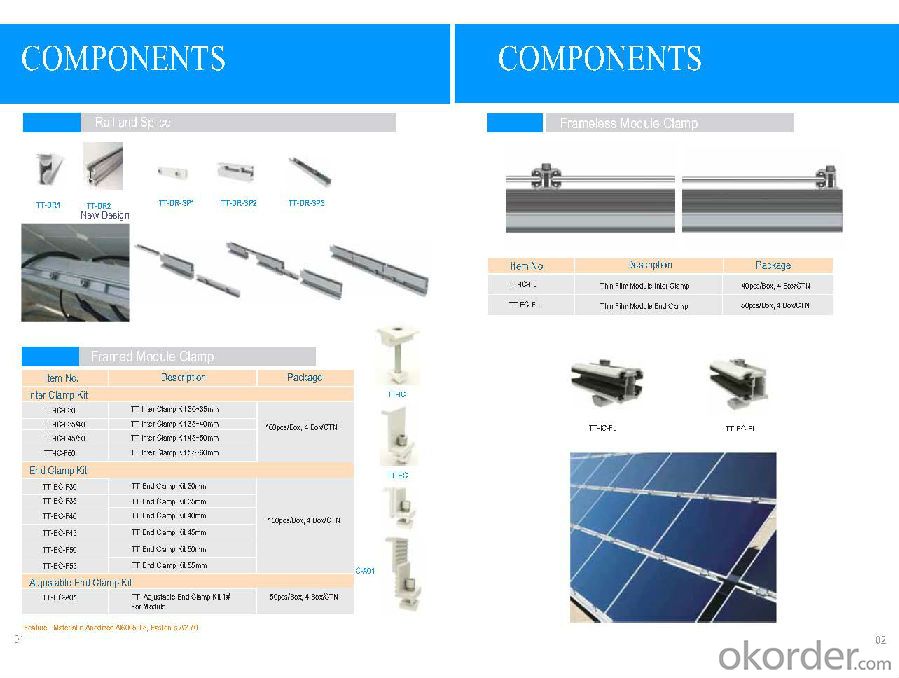

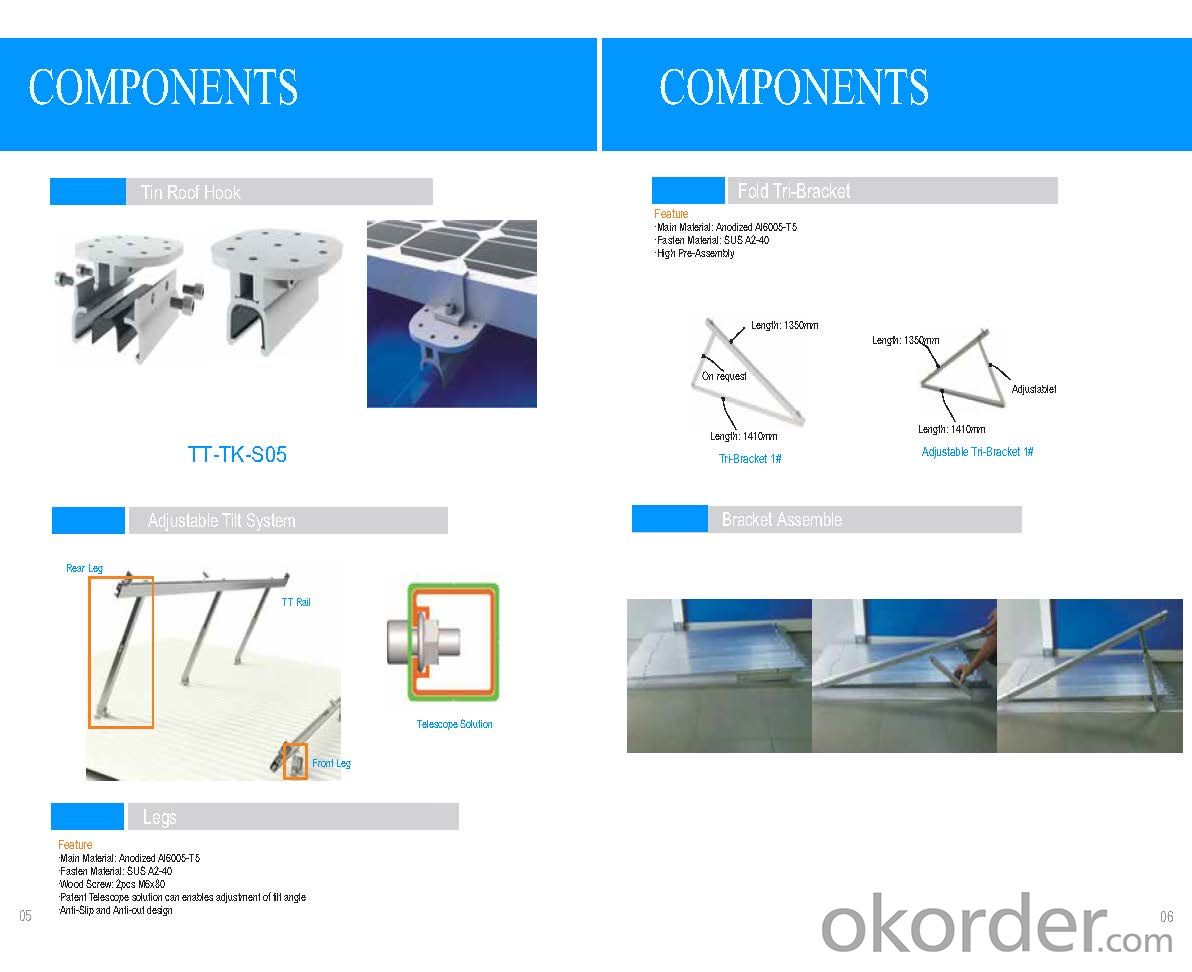
- Q:How does a solar mounting system affect the roof's ventilation requirements?
- A solar mounting system can affect the roof's ventilation requirements by potentially obstructing airflow and reducing the natural ventilation of the roof. This is because the solar panels and the mounting structure can create a barrier on the roof's surface, limiting the airflow and potentially causing heat buildup. As a result, it may be necessary to modify or enhance the roof's ventilation system to ensure proper airflow and prevent potential issues such as moisture buildup or reduced energy efficiency.
- Q:What are the environmental impacts of solar mounting systems?
- The environmental impacts of solar mounting systems are generally positive. These systems require the use of materials such as aluminum, steel, and concrete, which do have environmental impacts associated with their production. However, once installed, solar mounting systems have a minimal impact on the environment. They generate clean energy without emitting greenhouse gases or pollutants, thereby reducing reliance on fossil fuels and mitigating climate change. Additionally, solar mounting systems can be designed to minimize land disturbance and can even be installed on already developed areas like rooftops or parking lots, preserving natural habitats. Overall, the environmental benefits of harnessing solar energy far outweigh any initial impacts associated with the production and installation of solar mounting systems.
- Q:Are there any specific requirements for installing solar mounting systems in areas with high winds?
- Yes, there are specific requirements for installing solar mounting systems in areas with high winds. These requirements typically include using strong and durable materials for the mounting system, such as stainless steel or aluminum, to ensure they can withstand the force of the wind. Additionally, the system should be securely anchored to the ground or roof structure to prevent movement or damage during strong winds. It is also important to consider the orientation and tilt of the solar panels to minimize wind resistance. Overall, the aim is to design and install the mounting system in a way that can effectively withstand high wind speeds and minimize the risk of damage.
- Q:Can a solar mounting system be used in areas with limited access to demand response programs?
- Yes, a solar mounting system can still be used in areas with limited access to demand response programs. Demand response programs are typically designed to incentivize energy consumers to reduce their electricity usage during peak demand periods. While participating in these programs can provide additional benefits and revenue streams for solar system owners, they are not a prerequisite for installing and operating a solar mounting system. Solar energy can still be generated and consumed on-site, reducing reliance on grid electricity and providing cost savings, even in areas without demand response programs.
- Q:Can solar mounting systems be installed on flat ground?
- Yes, solar mounting systems can be installed on flat ground. In fact, flat ground is one of the most common types of surfaces where solar panels and their mounting systems are installed. The flat ground provides a stable and straightforward foundation for the mounting system, making it easier to set up and maintain the solar panels.
- Q:Can a solar mounting system be used with solar-powered planes?
- No, a solar mounting system is specifically designed to support solar panels on rooftops or ground-mounted installations, and is not compatible with solar-powered planes. Solar-powered planes require a completely different set of technologies and systems to generate and store solar energy, as well as to power the aircraft.
- Q:Can a solar mounting system be used with solar air heating systems?
- Yes, a solar mounting system can be used with solar air heating systems. Solar mounting systems are designed to securely hold solar panels in place, regardless of the type of solar technology being used. So, whether it is for photovoltaic panels or solar air heating systems, a solar mounting system can be adapted and utilized effectively.
- Q:Can a solar mounting system be installed on a rooftop with a high-slope roof?
- Yes, a solar mounting system can be installed on a rooftop with a high-slope roof. However, it may require special considerations and engineering expertise to ensure the stability and effectiveness of the system.
- Q:Can solar mounting systems be installed on rooftops with antennas?
- Yes, solar mounting systems can be installed on rooftops with antennas. However, it is essential to consider the structural integrity and placement of the antennas to ensure that they do not obstruct the solar panels or compromise the functionality of the antennas.
- Q:Are there any specific requirements for installing a solar mounting system on a rooftop with wind turbines?
- Yes, there are specific requirements for installing a solar mounting system on a rooftop with wind turbines. The key consideration is ensuring adequate spacing and clearance between the two systems to avoid any potential conflicts or interference. It is important to consult with experts and follow industry standards and guidelines to ensure a safe and efficient installation that maximizes the performance of both the solar and wind systems.
1. Manufacturer Overview |
|
|---|---|
| Location | |
| Year Established | |
| Annual Output Value | |
| Main Markets | |
| Company Certifications | |
2. Manufacturer Certificates |
|
|---|---|
| a) Certification Name | |
| Range | |
| Reference | |
| Validity Period | |
3. Manufacturer Capability |
|
|---|---|
| a)Trade Capacity | |
| Nearest Port | |
| Export Percentage | |
| No.of Employees in Trade Department | |
| Language Spoken: | |
| b)Factory Information | |
| Factory Size: | |
| No. of Production Lines | |
| Contract Manufacturing | |
| Product Price Range | |
Send your message to us
Solar Panel Monting System TT-SK-01
- Loading Port:
- Shanghai
- Payment Terms:
- TT OR LC
- Min Order Qty:
- -
- Supply Capability:
- 50万套 set/month
OKorder Service Pledge
OKorder Financial Service
Similar products
New products
Hot products
Related keywords
